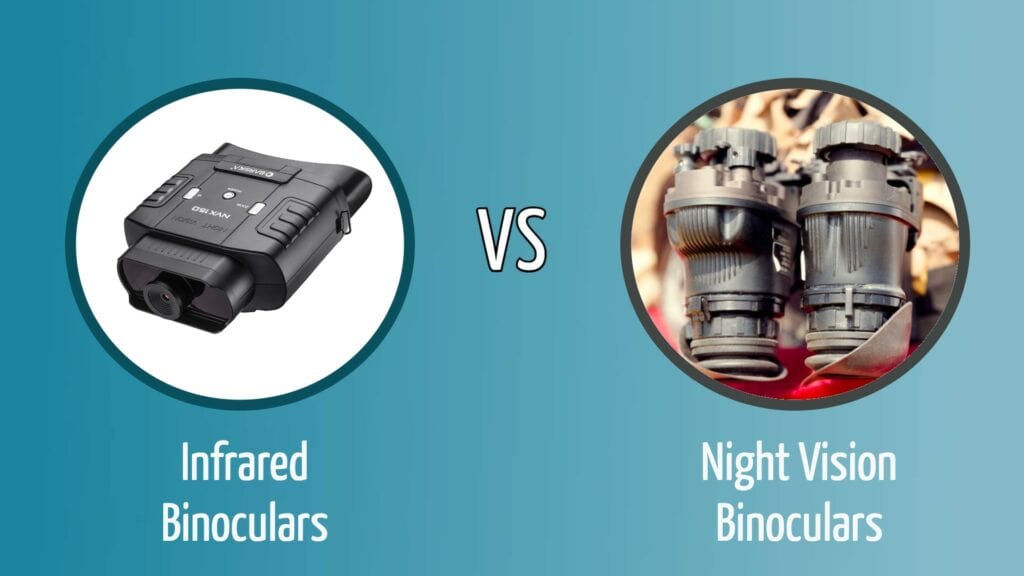Infrared Binoculars vs. Night Vision: Which Should I Choose?
Last Updated on

Infrared binoculars and night vision goggles offer similar functions. They are both designed to enhance or improve vision during low-light conditions. However, they use different technologies to achieve the result.
Night vision uses trace amounts of light that are present and enhances this so that it can be better seen by the human eye, so it needs some low-lighting level to be effective. Infrared detects infrared waves that are given off by heat sources, and the difference between heat levels provides contrast so that the human eye can discern shapes and figures even where there is no light.
Although the two provide similar results, they work in different situations, use different technology, and they are beneficial in different circumstances. Read on to discover the differences between infrared binoculars and night vision to help you determine which is the right choice for you.

Overview of Infrared Binoculars:
Infrared, also called thermal imaging technology, measures the temperature of objects and surfaces compared to other objects and surfaces around them and shows different heat levels with different colors and brightness. The hotter the object, the easier it is to see. It does not require any light to function, unlike night vision, which makes it useful in very dark situations.

How It Works
Infrared binoculars contain infrared sensors. These sensors detect the temperature of objects and do not rely on any source of light to do so. The higher the temperature of an object, the brighter it is displayed in the binoculars. The sensors can detect minute differences in temperature, which means that they can differentiate between two objects with very similar temperatures.
The objects do not need to give off their own heat to be picked up either. While animals and people naturally radiate heat, and this is “seen” by the infrared sensors, even objects like rocks and dirt have a heat signature. This is because they gather heat from the sun during the day and ambient heat throughout the day, and they give this heat off during the night.
When to Choose Infrared Binoculars
Infrared sensors are used in a wide range of applications and on a variety of products. Infrared cameras are used in security systems and may also be used on vehicles to help with parking and maneuvering at night. Infrared binoculars are also a common use of the technology and are used in the military, as well as by hunters. You should choose infrared binoculars when you are operating in very low or no light conditions because this technology does not require any light whatsoever to function properly.
- Does not require any light to work
- Minute differences in temperature can be detected
- Detailed images
- Detect the temperature of all objects, not just living creatures or hot objects
- Expensive compared to night vision

Overview of Night Vision:
Night vision is different from infrared because it requires at least some light to operate. It essentially magnifies what little light there is to make it more discernible to the human eye. Night vision has been used for military equipment and cameras for longer than infrared because it is more affordable, but it is not as beneficial because of its need for light.

How It Works
Night vision detects small amounts of light and then magnifies it substantially so that the human eye can see that light. The technology works with a small amount of light, but if there is too much light, images become undistinguishable, and the technology becomes useless. Unfortunately, there can be too much light for night vision to work properly.
Infrared-illuminated cameras use near-infrared beams, which are projected off the image being viewed. The sensors can then pick this light up and create a discernible image. However, these do still require light to be able to work, and this means that they only really work at close range while providing low-quality images.
When to Choose Night Vision
Night vision is most often used over infrared when budget is the primary deciding factor. Night vision is cheaper, even though infrared costs have come down. If you are looking to enhance low lighting conditions, will not need to enhance images when light starts to creep in, and do not need crystal clear images, night vision is a good option.
- Cheaper than infrared
- Works with minimal amounts of light
- Won’t work with more than minimal light
- Image quality is lacking

Which Is Better?
Lighting Levels
When deciding whether to buy and use infrared or night vision, one of the most important factors is the level of light that the device will be used in. Night vision requires some light, but only works with very low-level lighting. In contrast, infrared goggles work in any light level, from pitch black to full daylight. This means that they are useful in a wider range of circumstances and can continue to be used even if light levels change while they are being used.
Conditions
The ability to work in different lighting conditions also makes infrared the better choice for different conditions. For example, fog and smoke can greatly reduce visible light to the extent that night vision is no longer effective, but because infrared will work in total darkness, it can still be used even in these and other conditions.

Budget
Infrared is a more expensive technology, although, as is the way with technology, it is getting cheaper and infrared binoculars are becoming more accessible. However, if budget is a major concern, then night vision remains the clear winner, with infrared being the better choice with higher budgets.
Image Quality and Clarity
Night vision takes existing light and magnifies it. The result is a green-tinted image. While there are some differences in the brightness and shade of green, it can be very difficult to discern between various green colors. The result is an image that takes a lot of getting used to and that lacks detail and clarity. Infrared also shows images in different colors than we would normally witness, but there’s a more diverse color range that includes yellows, reds, and dark colors. Images can appear sharper, and details are clearer and easier to see.

Conclusion
Generally, infrared is considered the superior technology when compared to night vision. It works in any light level, including total darkness. It also produces images that appear clearer and have greater levels of detail. However, night vision is cheaper, although it will only work in minimal lighting conditions and will not work with too much light or no light. The decision of whether to choose infrared binoculars or night vision usually comes down to budget. If the individual can afford infrared, they opt for infrared. Otherwise, they will buy night vision.
Featured Image Credit: (L) Amazon, (R) Arturs-Budkevics, Shutterstock
About the Author Robert Sparks
Robert’s obsession with all things optical started early in life, when his optician father would bring home prototypes for Robert to play with. Nowadays, Robert is dedicated to helping others find the right optics for their needs. His hobbies include astronomy, astrophysics, and model building. Originally from Newark, NJ, he resides in Santa Fe, New Mexico, where the nighttime skies are filled with glittering stars.
Related Articles:
How to Collimate Binoculars: 9 Expert Tips
When Were Binoculars Invented? History, Today & Future
Can You Use Binoculars to Look At Stars? How to Choose the Right Pair
How to Choose Binoculars for Bird Watching: 10 Expert Tips
Binocular Magnification Chart: Numbers & Distances Compared
What Is the Best Binocular Magnification for Hunting? Optical Features Explained
What Does 20X50 Mean on Binoculars? Our Helpful Guide
10 Best Binoculars in Canada of 2024: Reviews & Top Picks
